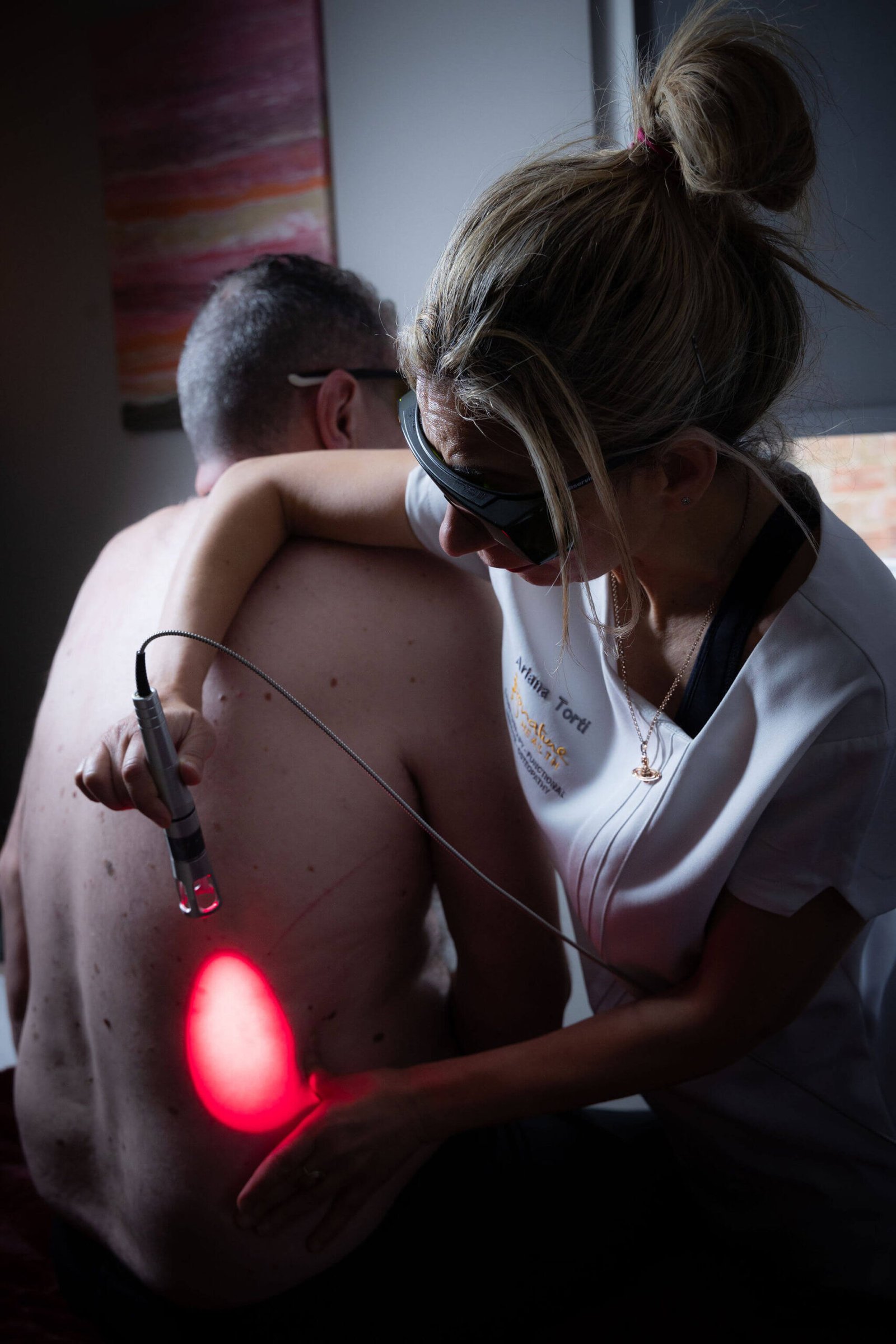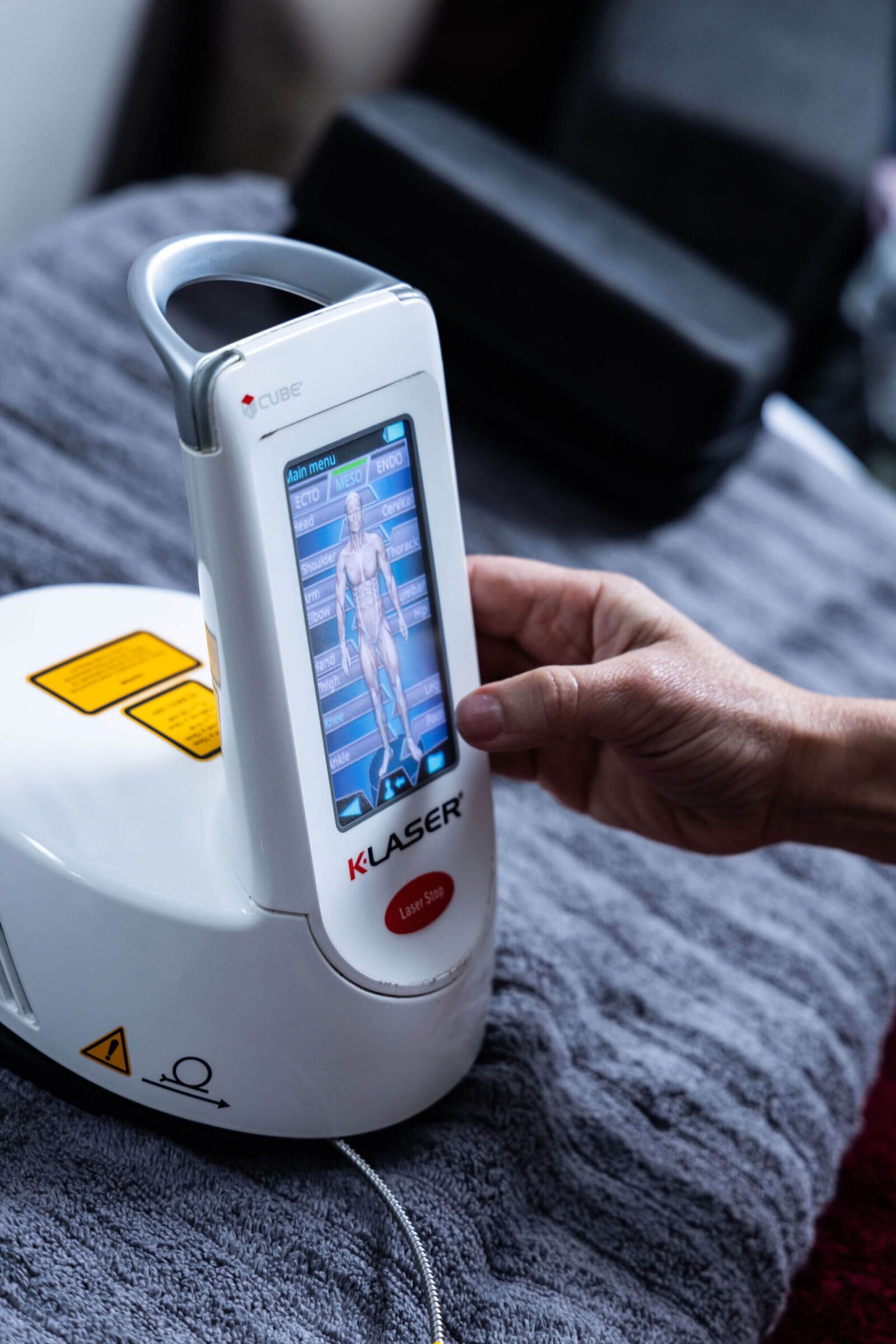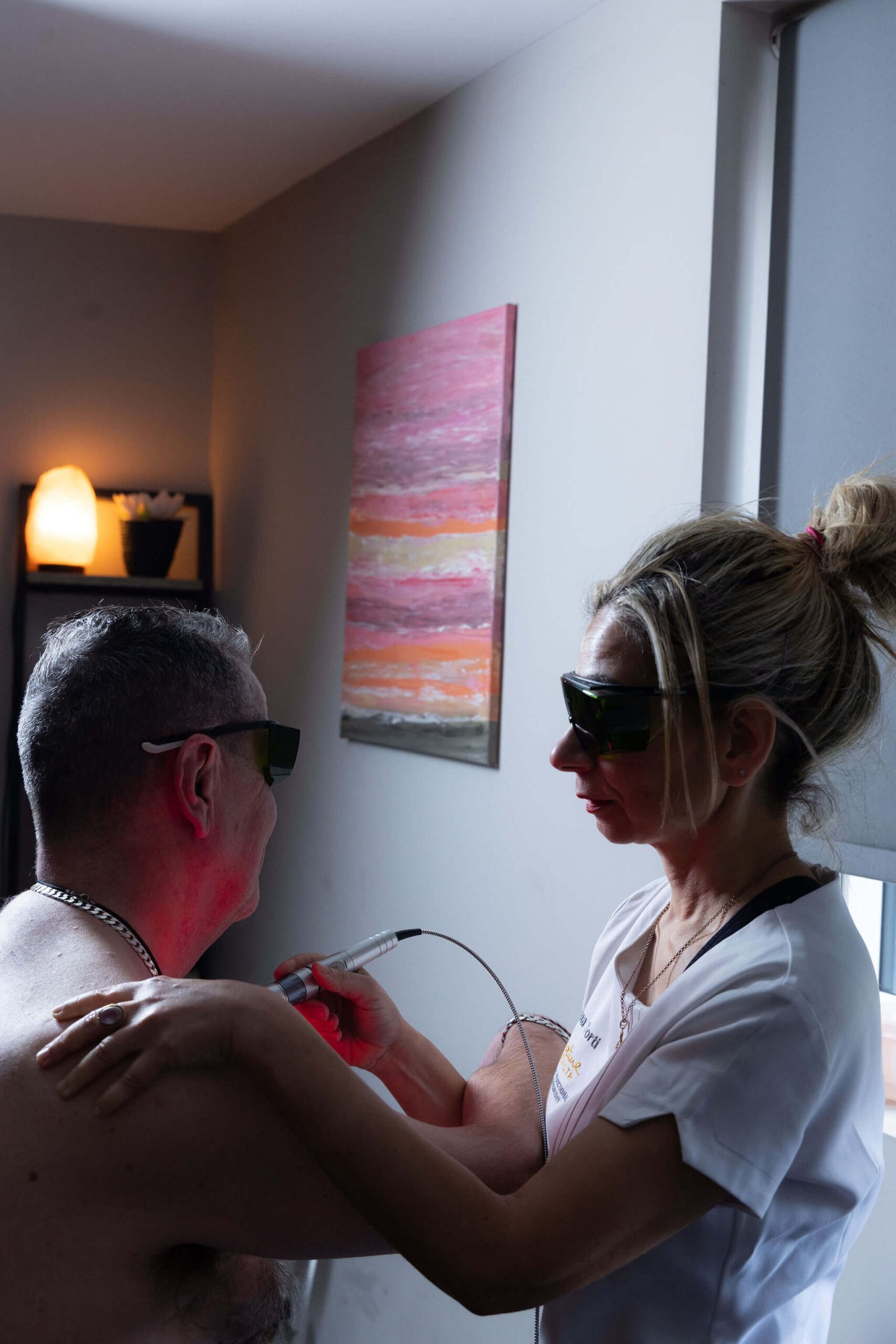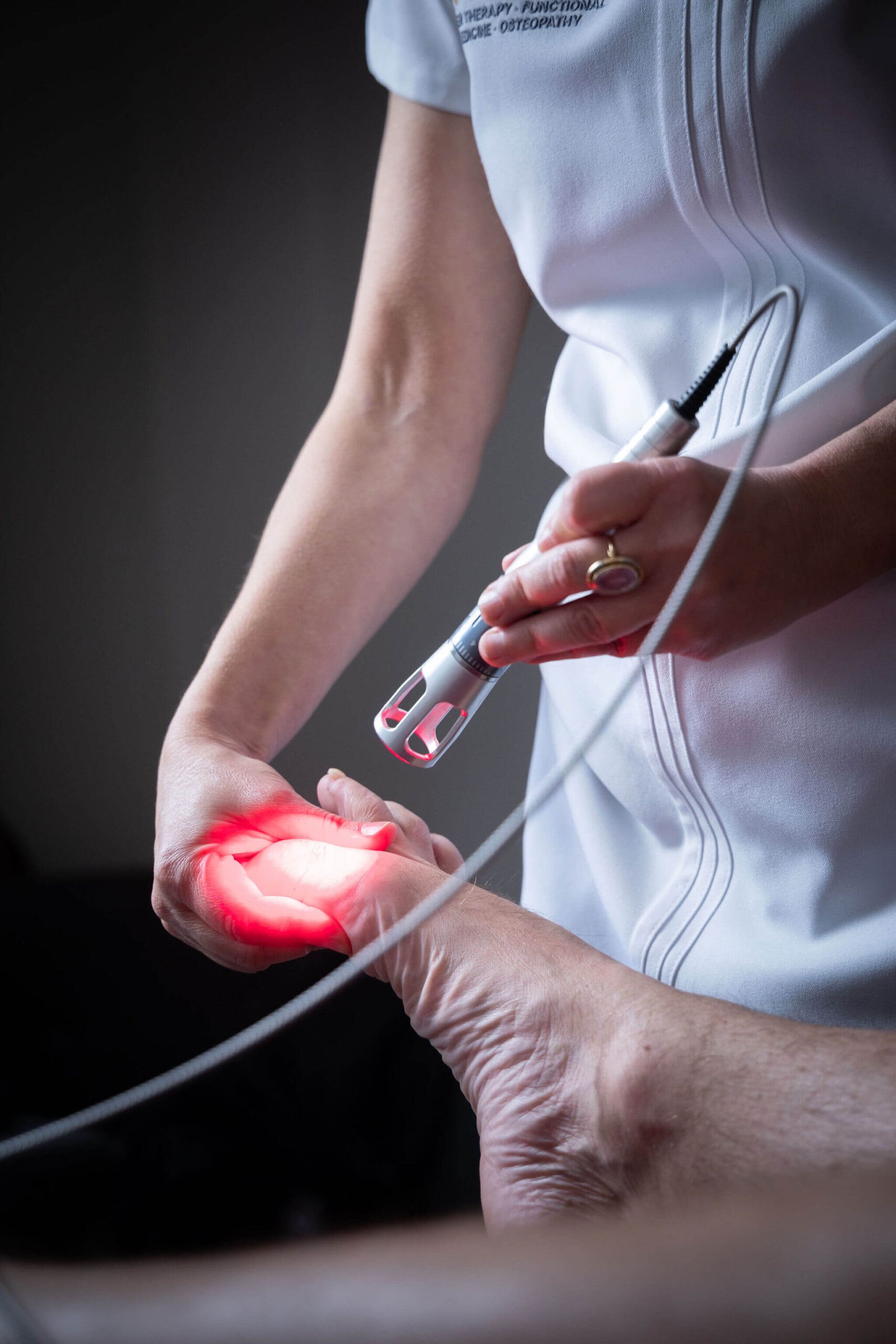What is K-Laser therapy?
K-Laser therapy is a painless, non-invasive treatment that uses medical-grade laser light to speed up the body’s natural healing process. It is commonly used in sports medicine, post-surgery recovery, and chronic pain management.
Which conditions can it help with?
⚕︎Chronic pain conditions like arthritis, fibromyalgia, or nerve pain
⚕︎Sports injuries such as ligament sprains or muscle tears
⚕︎Post-surgery faster healing
⚕︎Inflammation issues like tendonitis, plantar fasciitis, bursitis
⚕︎Fracture recovery








What are the benefits of using K-Laser?




How does it Help?
"I would highly recommend Ariana. The laser treatment has worked great on my scaphoid and has got me back to work. Being a bricklayer my wrist was very sore after surgery with some rest and treatment I'm back working & fit with a very short recovery period."
Chris Land
Frequently asked questions
Laser therapy was discovered by a student of Einstein in 1967. As he was treating breast cancer with Laser, he noted that incisions to reach tumours, healed faster where Laser was used. This lead the way to further investigation and new fields of research with culminated with Laser therapy as it is used today in versatile ways. Nowadays, K-Laser provides very advanced therapy in its class. It works through the principle of photobiomodulation. This is light that effects the way your body works at a cellular/microscopic level. K-Laser increases vasodilation, the widening of your blood vessels, to increase oxygenation, metabolism, mitochondrial function. It is a principle that can apply to most parts of the body, and has a vast arrays of application. K-Laser doesn’t target the injury or pathology (process of disease) as such, and we are not claiming curing diseases as such. However, by stimulating cellular activity, K-Laser enhances:
Stem cell migration
Energy production
Collagen deposition
Which can help with healing faster, decreasing pain, improving movement, protecting joints from excessive cartilage erosion
Let’s strip the medical jargon down further. The basics are that we need oxygen, water, food, sunlight. We are not evolved to living indoors and fully clothed. Many chemical reactions which are necessary in our bodies are mediated by sunlight. Light provides stimulation for vitamin D, and serotonin levels drop when we are not exposed to sunlight. Our lifestyles may inhibit our ability to heal. Are we working from home? Do we play computer games in our spare time? Are we covering our bodies in extensive clothing when we are out? Do we do little physical activity?
All of the above can impact on cell regeneration, movement, pain, energy and joint health. By making the tissues work better, K-Laser therapy helps improve how we function.
Many patients notice improvements after just a few sessions, with significant relief often occurring within 3-6 treatments. The exact timeline depends on the severity of the condition and the body’s response to therapy.
Unlike painkillers, which mask symptoms, K-Laser therapy influences our body chemistry to function better naturally, without synthetic medication. Ideal with you do not respond well to over-the-counter or prescribed drugs.
Unlike steroid injections and other medical interventions, K-Laser therapy is non-invasive, has no side effects or long-term risks. Ideal if you are scared of needles, have stomach issues, struggle to swallow medication
Unlike surgery, it requires minimal downtime, so you can return to daily activities quickly. You should avoid intensive gym sessions or heavy weight lifting for 24 hours after treatment, but if being back in business is key, K-Laser can definitely help with business continuity.
Ariana integrates Laser seamlessly with osteopathy.
She still uses the same clinical reasoning, diagnoses and treats with hands as required/requested, so you get a richer experience. The fees are capped so you do not have to worry about hidden costs or a fee upgrade for adding K-Laser therapy, it is all part of your treatment under one flat fee.
Nervous patients who are looking for an osteopathic/holistic approach without hand contact or with minimal touch, can relax as they will not be “manhandled” and manual palpation can be kept to a minimum.
Patients with contraindications for osteopathic manipulations, can be safely and effectively treated with K-Laser therapy.
Patient who cannot be manipulated (due to patient/practitioner size ratio, or who do not “crack” easily), still receive an effective treatment with K-Laser. In any case, there is growing evidence to suggest that a majority of patients may get some side effects from manipulations, which challenges the reasoning as to why manipulations are so popular.
Unlike osteopathy in some cases, such as fractures, K-Laser can be applied right after an injury, so patients can get back to their daily activities, jobs or sports as soon as possible.
Osteopathy & K-Laser Therapy
First consultation: 1 hour – £100
Follow-up treatment: 30 minutes – £75
Comprehensive follow-up treatment: 1 hour – £100
Buy 5 Osteo & K-Laser therapy 1-hour sessions, Get 6 th Free = £500
Buy 5 Osteo & K-Laser 30-min sessions, Get 6 th Free = £375
What evidence is there?
“We show that LLLT reduces pain immediately after treatment in acute neck pain and up to 22 weeks after completion of treatment in patients with chronic neck pain”.
Reference: Chow R. T. et al, Efficacy of low-level laser therapy in the management of neck pain: a systematic review and metaanalysis ofrandomised placebo or active-treatment controlled trials. Lancet. 2009 Dec 5;374(9705):1897-908. doi: 10.1016/S0140-6736(09)61522-1. Epub 2009 Nov 13.
“Statistically significant improvements [in the treatment of knee osteoarthritis] were indicated in respect to all parameters such as pain, function, and quality of life (QoL) measures in the post-therapy period compared to pre-therapy in both active laser groups […] compared with placebo laser group.
Reference: Gur A. et al, Efficacy of different therapy regimes of lowpower laser in painful osteoarthritis of the knee: a doubleblind andrandomized-controlled trial. Physical Medicine and Rehabilitation, School of Medicine, Dicle University, Diyarbakir, Turkey.
“The LLLT [Low Level Laser Therapy] and steroid groups showed significantly lower inflammation […] in both early […] and late phases of evaluation […] compared to positive control group in early and late stages of assessment […]. However, the best results [..] were achieved in early phase of the steroid group as well as late phase of the LLLT group. […] LLLT method has a long-term promising effect on reducing inflammation severity of TMJ similar to betamethasone in earlier stages”.
Reference: Herpich CM, et al. Analysis of laser therapy and assessment methods in the rehabilitation of temporomandibular disorder: a systematic review of the literature. J Phys Ther Sci. 2015 Jan;27(1):295-301. doi: 10.1589/jpts.27.295. Epub 2015 Jan 9.
“The average success rate across the first five studies was 84% […]. The average pain duration prior to successful photoradiation was 2 years. Photoradiation is a promising new, conservative treatment for mild/moderate CTS [Carpal Tunnel Syndrome] cases […]. It is cost-effective compared to current treatments”.
Reference: Naeser MA, Photobiomodulation of pain in carpal tunnel syndrome: review of seven laser therapy studies. Photomed Laser Surg. 2006 Apr;24(2):101-10.
“We already demonstrated that low-level laser therapy (LLLT) stimulates the synthesis and organization of collagen I, […]. The aim of this study was to evaluate the effects of LLLT […] during the inflammatory and remodeling phases. […]. Our results showed that the pulsed LLLT seems to exert an anti-inflammatory effect over injured tendons, with reduction of the release of proinflammatory cytokines, such as TNFα and the decrease in the i-NOS activity. Thanks to the pain reduction and the facilitation of movement, there was a stimulation in the TGF-β and IL-1β release. In conclusion, we believe that pulsed LLLT worked effectively as a therapy to reestablish the tendon integrity after rupture.
Reference: Da Ré Guerra F. et al, Low-level laser therapy modulates pro-inflammatory cytokines after partial tenotomy. Lasers Med Sci. 2016 May;31(4):759-66. doi: 10.1007/s10103-016-1918-7. Epub 2016 Mar 16.
“The results of the present study suggest that HILT [High Intensity Laser Therapy] is a reliable, safe, and effective treatment option in LE [Lateral Epicondylitis (Tennis Elbow)] patients in the short and long term considering pain, functional status, and quality of life”.
Reference: Akkurt E. et al, Long term effects of high intensity laser therapy in lateral epicondylitis patients. Lasers Med Sci. 2016 Feb;31(2):249-53. doi: 10.1007/s10103-015-1841-3. Epub 2015 Dec 29.
“Our findings obtained after 15 treatment sessions with the experimental protocol suggested greater effectiveness of HILT [High Intensity Laser Therapy] than of US [Ultrasound] therapy in the treatment of LBP [Low Back Pain], proposing HILT [Laser Therapy] as a promising new therapeutic option into the rehabilitation of LBP”.
Reference: Department of Physical Medicine and Rehabilitation, University of Foggia, Foggia, Italy. Short-term effects of high-intensity laser therapy versus ultrasound therapy in the treatment of low back pain: a randomized controlled trial. Eur J Phys Rehabil Med. 2011 Sep;47(3):367-73. Epub 2011 Jun 8.
“We conclude that LLLT [Low Level Laser Therapy] is a viable option in the conservative treatment of discogenic back pain, with a positive clinical result of more than 90% efficacy, not only in the short-term but also in the long-term, with lasting benefits.
Reference: Asia Medical Pain Centre, Mong Kok, Hong Kong, People’s Republic of China. Can intractable discogenic back pain be managed by lowlevel laser therapy without recourse to operative intervention? J Pain Res. 2015 May 26;8:253-6. doi: 10.2147/JPR.S84458. eCollection 2015.
“The application of laser therapy results in decreased severity of oral mucositis from radiation and chemotherapy. Our study shows that the application of low-level laser therapy in the treatment of transplant mucositis has excellent efficacy in relieving the symptoms and severity of mucositis.”
Reference: Rocco Franco et al, Low-Level Laser Therapy for the Treatment of Oral Mucositis Induced by Hematopoietic Stem Cell Transplantation: A Systematic Review with Meta-Analysis, Medicina (Kaunas). 2023 Aug 3;59(8):1413. doi: 10.3390/medicina59081413
“Evidence-based recommendations on low-level laser therapy for preventing or treating oral mucositis caused by radiotherapy or chemotherapy. This involves applying low-energy lasers to the affected tissue”.
Reference: National Institute for Health and Care Excellence (NICE), Low-level laser therapy for preventing or treating oral mucositis caused by radiotherapy or chemotherapy, Interventional procedures guidance, Reference number:IPG615, Published: 23 May 2018
“FM [Fibromyalgia] pathophysiology is characterized by an imbalance in the central nervous system, with a reduction in neurotransmitters and an inhibitory release of serotonin. Together, these affect pain conduction and result in several changes in pain sensitivity and modulation […]. It seems that the medications associated with worsening QoL [quality of life] in FM patients may induce […] an increase in pain perception [..]. Some of the most significant effects of LLLT [Low level Laser Therapy] are pain reduction, its anti-inflammatory properties, and vasodilation, which have the ability to interfere in pain physiology and muscle microcirculation […]. We believe that all of these physiologic effects could be associated with neural control reducing the cycle of pain […].
Reference: Ranieli Cavalcante dos Santos, et al. Acute low-level laser therapy effects on peripheral muscle strength and resistance in patients with fibromyalgia, Lasers in Medical Science, https://doi.org/10.1007/s10103-019-02816-2
“This study provides evidence that LHT [Laser Heat Therapy] may be a beneficial modality for women with FM [Fibromyalgia] in order to improve pain and upper body range of motion, ultimately reducing the impact of FM”.
Reference: Lynn Panton, PhD,et al. Effects of Class IV Laser Therapy on Fibromyalgia Impact and Function in Women with Fibromyalgia, THE JOURNAL OF ALTERNATIVE AND COMPLEMENTARY MEDICINE, Volume 19, Number 5, 2013, pp. 445–452, Mary Ann Liebert, Inc., DOI: 10.1089/acm.2011.0398
“Thermal therapy has a positive effect on fibromyalgia-induced pain[…]. We speculate that this effectiveness has underlying mechanisms involving both the central nervous system and the peripheral nervous system. Clinically, nonpharmacological treatment for peripheral organization in fibromyalgia patients is important, and physicians need to consider both central and peripheral tissue as therapeutic targets.
Reference: Yuichiro Honda, et al. Effects of Physical-Agent Pain Relief Modalities for Fibromyalgia Patients: A Systematic Review and Meta-Analysis of Randomized Controlled Trials. Hindawi Pain Research and Management, Volume 2018, Article ID 2930632, 9 pages, https://doi.org/10.1155/2018/2930632
“This study suggests that LLLT provides relief from the symptoms of fibromyalgia and could be an important therapeutic tool to lessen the impact of the disease, decrease pain, and improve quality of life for patients”.
Reference: J. A. Ruaro, et al. Low-level laser therapy to treat fibromyalgia, Lasers Med Sci. DOI 10.1007/s10103-014-1566-8
“Laser therapy is a safe and effective treatment in cases with FM [Fibromyalgia]. Additionally, the present study suggests that the […] laser therapy can be used as a monotherapy or as a supplementary treatment to other therapeutic procedures in FM”.
Reference: Ali Gur, et al. Effects of low power laser and low dose amitriptyline therapy on clinical symptoms and quality of life in fibromyalgia: a single-blind, placebo-controlled trial, Rheumatol Int (2002) 22: 188–193, DOI 10.1007/s00296-002-0221-z
“1. Methods of pain management are fundamentally different for neuropathic pain (nonspecific, primary) […], and nociceptive pain (specific, secondary), which includes all types of pain arising from trauma, inflammation, etc.
2. In the treatment of patients with FM [Fibromyalgia], it is necessary to use only complex treatment, including the use of various methods of laser therapy”.
Reference: Serguei Borisovich Kisselev, Sergey Vladimirovich Moskvin, The Use of Laser Therapy for Patients with Fibromyalgia: A Critical Literary Review, J Lasers Med Sci 2019 Winter;10(1):12-20
“In reviewing the peer-reviewed medical literature, [Laser Therapy] appears to be an effective approach to improving pain control and accelerate healing when used as an adjuvant to analgesic medications and physiotherapy for superficial medical and surgical conditions […]. [Laser Therapy] has been reported to be […] effective […] in treating acute headache, degenerative joint conditions, lateral epicondylitis, neuropathic pain syndromes and a wide variety of musculoskeletal disorders. […] Use of more powerful photobiomodulation laser therapy could potentially improve the lives of millions of patients suffering from the painful symptoms of fibromyalgia while also reducing the risk of opioid dependence”.
Reference: Paul F. White et al, Treatment of drug‑resistant fibromyalgia symptoms using high‑intensity laser therapy: a case‑based review, Rheumatol Int, DOI 10.1007/s00296-017-3856-5
Your Health, it’s Personal
